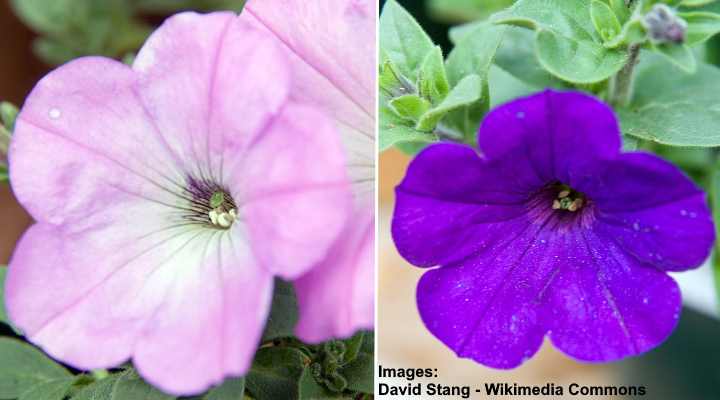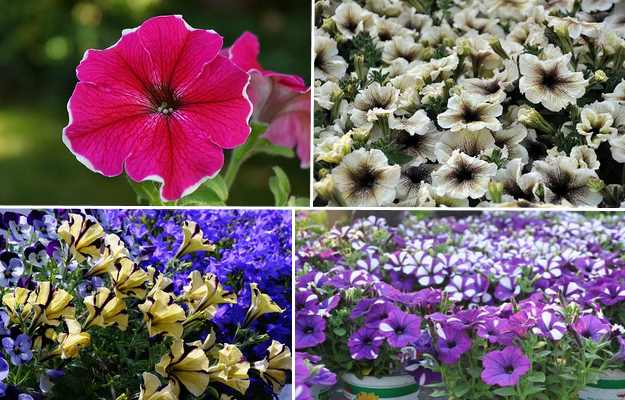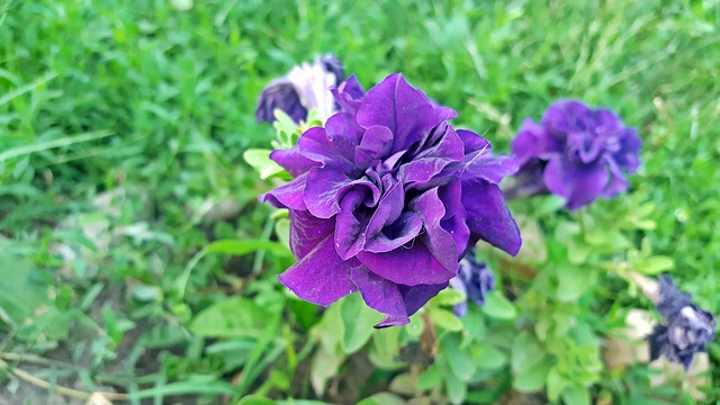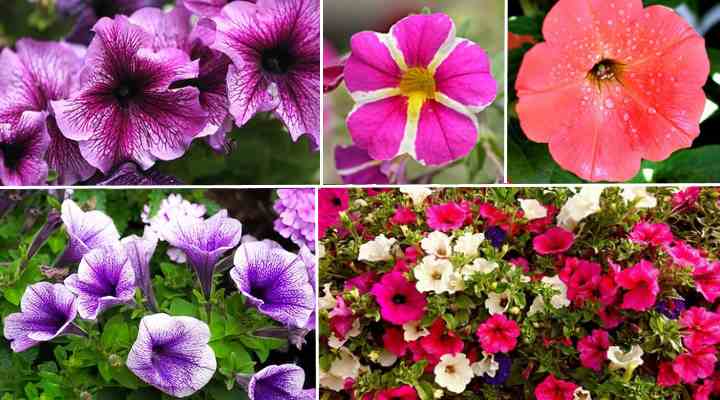Petunias come in a variety of colors, including yellow, red, purple, white, orange, and blue. Petunia blooms come in a variety of colors and patterns, including striped, solid, or speckled designs. Petunia blooms are lovely, growing in containers, hanging baskets, flower borders, or spreading colorful ground cover. They bloom continuously on long cascading stems. Petunias bloom continuously throughout the summer, and new varieties will continue to bloom without being deadheaded.
These mounding plants with trumpet-like flowers are particularly popular, and among the most popular types is wave petunias. Spread or trailing petunia plants, large-leaved grandiflora petunias, robust multiflora petunias, and milliflora petunias with tiny flowers are just a few of the hundreds of types available. There is a kind of petunia that will work in practically any garden setting, regardless of your garden or growing zone.
Petunia flowers require a lot of care, so this article is a guide to planting, growing, and caring for them. In this article, you’ll learn how to add summer color to your garden, patio, balcony, or container garden by selecting appropriate blooming petunias varieties. You can ensure that the colorful, showy flowers bloom all summer long with a few handy tips on growing petunias in hanging baskets, mixed flower beds, or pots.
Are Petunias Perennials or Annuals?

In warmer climates, petunias are tender perennials, but in colder climates, they are flowering annuals. Frost and chilly temperatures are incompatible with petunia plants. Petunias can survive for two or three years in most climates if they are protected from frost.
Most petunias grow as perennials in USDA zones 10 and 11. Nonetheless, in colder areas, treating petunias as annuals and overwintering them indoors is required. You may also take cuttings from petunias in the late summer, when the weather gets warmer, to start new plants the following year.
Petunia Cold Tolerance
The cold doesn’t sit well with Petunias. When daytime temperatures fall below 61°F (16°C) and nighttime temperatures fall below 57°F (14°C), Petunia blooms slower. Nonetheless, if it’s as cold as 39°F (4°C) outside, the tender perennials should survive. If the temperature drops below 32°F (0°C), the thin leaves and flowers will perish, so it is critical to keep petunias safe from harsh weather.
Petunias may be helped to withstand cold temperatures in a variety of ways. You may protect petunias in the evening with sheets until the temperature returns to normal in the morning, for example, when it falls below 57°F (14°C).
If you grow the petunias in hanging baskets or containers, it’s simpler to keep them safe from chilly temperatures. Moving the hanging basket flowers or pot to a warmer, protected spot is simple if you’re expecting chilly weather.
Do Petunias Need Sun or Shade?

Petunias need at least five and a half hours of sunlight every day to thrive. The cascading or mounding stems bloom all summer when there is plenty of sunlight. Petunias grow leggy and produce fewer blooms when there is too much shade and not enough sun. As long as they are in fertile soil that is kept moist, petunias will continue to bloom, growing in full sun and heat.
How Long Do Petunia Flowers Last?
In mild climates, Petunia plants grow as tender perennials outdoors for two to three years. In colder climates, it is crucial to overwinter petunia blooms indoors in order for them to survive. Petunias blooms freely until the end of summer, beginning in late spring.
Petunias bloom abundantly all summer, sometimes even before the first frost, in full sun. The use of petunias to deadhead encourages heavier foliage and additional blooms, which extends the bloom season.
Types of Petunia Flowers
Window boxes, borders, containers, and hanging baskets are all popular places to grow petunias. The sun-loving flowers are so popular in gardens because of their wide range of colors, mound growth, cascading floral stems, and easy care. It’s vital to choose the proper sort of plant to ensure that gorgeous petunia blooms bloom best.
Some petunias are appropriate for hanging baskets or window boxes, while others are better as ground cover. In hot, humid environments, some hardy petunia types flourish. Petunia flower size is the most common way to differentiate varieties. The five groups of petunias are described below:
Wave petunias Because of their spreading and trailing stems, which can grow up to 4 feet (1.2 meters) long, they are popular for hanging baskets. Purple, lilac, pink, red, and blue blooms bloom in abundance on the massive trumpet-shaped blossoms that surge in clusters.

Multiflora petunias Little pink, red, white, purple, and multi-colored blossoms cover the landscape. Single or double blooms can be found in the showy floral displays. These petunias are ideal for windy or wet conditions due to their sturdy cascading stems. Without much deadheading, these petunia blooms bloom well.
Grandiflora petunias In the petunia family, they are the biggest blooms. The huge, wavy petals of the funnel-shaped blooms can reach up to 5 inches (15 cm) broad. You’ll need to deadhead Grandiflora petunias on a regular basis in order for them to bloom. The blossoms are more likely to be damaged by heavy rain.
Supertunia petunias Bloomers are easy to grow and spread readily. The huge papery blooms come in a variety of pastel and bright neon hues. Variety with striped or speckled flowers are among the most spectacular Supertunia petunia blooms.

Cascadia and surfinia petunias For hanging baskets, the two most popular petunia varieties are The unusual flower colors and hues contrast with the trumpet flowers’ pronounced veining.

Milliflora petunias Among all the petunia groups, they have the smallest flowers. The tiny petunia blooms are about 1 inch (2.5 cm) broad, and the mound-covered foliage is covered in colorful blooms all season.
Calibrachoa or Million Bells Petunias-like flowers adorn these plants. species have a similar spreading growth habit and are related to petunias. Calibrachoa funnel-shaped petunia blooms have beautiful pastel hues. The blooms feature vivid veins and a dark core that stands out.

Calibrachoas (million bells) were formerly classified as part of the same genus as petunias, but are now categorized separately.
Petunia Flowers

Petunia blooms are trumpet-shaped or funnel-shaped blooms that bloom abundantly on stems. Plants in full bloom may resemble a mound of blossoms. Five joined petals make up the blossom. The petals are usually a lighter color than the center of the flowers and veins.
Petunia blossoms range in hue from white to purple. Petunia blossoms come in a variety of vibrant red, blue, purple, or yellow hues as well as pastel yellow, lilac, pink, or white hues. Petunias with black flowers are available in a variety of colors. The most spectacular petunia flowers are double blooms, and Petunia petals can be smooth or ruffled. Flowers may be solid colored or have contrasting striped or speckled designs, depending on the variety.
How do long petunia plants bloom?
Throughout the summer until early autumn, Petunia flowers bloom. Wave petunias, for example, are newer hybrids that don’t need deadheading to prolong the blooming season. If you regularly clip off dead or dying blossoms, varieties of petunias like grandiflora petunias last longer. It is critical to water petunias thoroughly, particularly in hot, bright weather, to encourage a lengthy blooming period. Petunias will last the summer, except from severe heat or humidity.
How much time does it take petunia to bloom?
From the time they are planted until they bloom, Petunias take six to eight weeks. If seedlings get sufficient light and grow in fertile, moist soil, petunias are typically quick growers. Seedlings should be kept between 65°F and 75°F (18°C and 24°C) for five to 15 days before they germinate.
How to keep petunia blooming
If you remove the dying flowers from most types of petunias, they will bloom longer. By removing the flowers, the plant will create more flowers rather than seed pods. If you grow petunias as border plants or ground cover, it may not be feasible to deadhead masses of flowers. Petunias growing in hanging baskets or containers should be deadheaded first.
Deadheading Petunia
From late spring until late summer, deadheading petunias prevents the bushy, cascading plant from fading. Petunias bloom and then produce seeds, which is how they reproduce. You’ll encourage the plant to continue blooming all throughout the growing season if you snip off wilting flowers.
How to Prune Petunia: If you want to eliminate the flowers from petunias, pruning is simple. Once the flowers and seed pods turn brown, use your fingers to pinch them. Then, just above the following set of leaves, trim the stems. By cutting the stem, the petunia will develop additional leaves and blooms.
How to Plant Petunia Flowers

Before transplanting them outdoors, grow them indoors until the weather improves. Before transferring petunias to the garden, outdoor container, or hanging basket, it’s often preferable to start them indoors.
When to plant petunia: It’s recommended to sow the seeds for petunias indoors ten to twelve weeks before your last frost date. When nighttime temperatures are between 55°F and 65°F (12°C and 18°C), you can plant petunias outdoors, although during the day it is around 65°F (18°C). Petunias should bloom rapidly after being planted outdoors.
Where to plant petunia: Petunias should be grown in full sun for at least six hours a day. Plant them in the shade of your yard in hot regions to ensure they don’t wilt. Petunias will survive some shade, but their growth will be hampered.
The best soil for growing petunia: Petunias thrive in soil with a pH of 6 to 6.5 (slightly acidic), which is ideal for growing petunias. Work in compost and peat moss when planting spreading petunias in the earth to improve the soil. Petunias thrive best in soilless mixes with slow-release fertilizer when grown in hanging baskets.
How to grow petunia from seed: Due to their tiny size, Petunia seeds can be difficult to germinate. Spread a few seeds thinly over moist potting soil and spray with a fine mist to produce petunias blooms from seed. In a sunny, temperature-range between 70°F and 85°F (21°C and 29°С), place the cover in direct sunlight without exposing it to temperatures.
Remove the plastic and place the seedling container in a location with an air temperature of roughly 65°F (18°C) when seedlings emerge. They receive between 16 and 18 hours of light every day when placed under fluorescent lights. Transfer seedlings to individual pots when they have three or more leaves.
How to Care for Petunia Flowers
During the growing season, water the area weekly to keep it moist but never soggy to care for petunias. In hot regions, Petunia blooms prefer bright light and some afternoon shade. Every three weeks or once a week, feed petunias with a balanced fertilizer to keep them spreading.
How to Care for Petunias in Pots: Petunia Container Care

Make sure to water your potted petunia when the top layer is dry; otherwise, it will not be cared for properly. Water the potting soil thoroughly every two to three days. Don’t water the surface soil layer unless it’s absolutely necessary. Every two weeks, apply a diluted liquid fertilizer to Petunias because they are heavy feeders.
For best development and the most vibrant possible petunia blossoms, choose a sunny location where the plants are exposed to six to eight hours of daily sunlight.
How to Care for Petunias During Winter
During the winter, many gardeners prefer to overwinter gorgeous petunia hybrids. Before the first frost in the winter, trim back petunias to around 2 inches (5 cm) tall. During the winter, keep the potting soil just moist by planting each plant in its own pot and placing the petunias in a cool, dark area.
You can also take petunias cuttings in the autumn, before the weather gets cold. When the roots appear, transfer the cuttings to small pots and root them in individual jars of water. Sow the seed on a sunny windowsill and keep the ground damp. You can plant overwintered petunias in hanging baskets, pots, along shrub borders, or as a spreading bedding plant for full sun ground cover in the spring after the last frost.
Petunia Propagation

The best and quickest way to grow petunias is via stem cuttings. In the autumn, take healthy petunia cuttings. Remove the lower leaves from 3″ to 5″ (7.5 – 15 cm) stems that are just below the nodes. Place the petunia cutting in a small pot of peat moss and perlite, then firm up the soil by pressing it round.
Cover the cuttings with plastic and mist the earth before securing it with the stems. Place in a cool and shaded area. Every second day, lightly mist the soil. The cutting should root in three to four weeks. After being planted, grow throughout the winter in a sunny position. You can move indoor-grown petunias to outdoor hanging baskets in the spring.
How Often to Water Petunia
The frequency of watering petunias varies depending on where they are blooming. Watering once a week is necessary for bushes or mounding petunias that are growing in the ground. watering more often may be required for spreading petunias Petunias that are grown in hanging baskets or jars dry out quicker. Therefore, in hot weather, water them once a day, and if it’s particularly hot, water them twice.
Petunia in Hanging Baskets

Petunias’ richly colorful, spectacular blossoms, cascading stems, and easy-care development make them popular in hanging baskets for porches and entrances. Petunias in hanging baskets are great for entrances, porches, arbors, and pergolas. In hanging baskets, varieties of wave petunias with their ruffled, double blooms are particularly stunning.
How to plant petunia in hanging baskets: To grow in hanging baskets, choose cascading, surfinia, or wave petunias. Use a drainage-equipped basket and a lightweight potting mix that has superb drainage. Use slow-release fertilizer in the potting soil since the soil in hanging baskets drains nutrients quickly.
How to care for petunia in hanging baskets: To ensure the cascading stems produce an abundance of flowers, sufficient watering is critical. When the top layer of soil dries, water petunias in hanging baskets. This entails watering petunias every few hours throughout the growing season.
Here are a few things to keep in mind when watering petunias in containers or hanging baskets:
- Never water the leaves or blossoms, but always the soil.
- Never allow the potting soil to get too wet
- Petunias cannot survive in dry conditions and thrive when they are watered abundantly and often.
What Causes Petunias to Wilt and Die
The most prevalent cause of petunias’ drooping and ceasing to develop is watering problems. The soil should never be completely dry because petunias like wet conditions. Nonetheless, by routinely watering your petunia when the soil is mostly dry, you may keep it healthy. Overwatering, on the other hand, may cause root rot and kill a petunia. Too much shade or a pest infestation are other reasons for petunias to wilt and die.
Leggy Petunias

Make sure your petunia has enough light and water it properly to avoid long stem development and poor bloom. Leggy petunias, on the other hand, may indicate that they aren’t receiving enough water. Frequent watering usually cures stretched growth in a sunnier area, such as the petunias container or hanging basket.
Because your petunia requires deadheading, leggy, unattractive stems with blooms at the end of the stems are another reason. When the blooms are no longer available, be sure to remove the flowers and seed pods. Prune stems by a quarter or half to restore bushy growth to a leggy petunia. Heavy pruning may cause a bushy plant to grow compact and produce a slew of trumpet flowers.
Yellow Leaves on Petunia Plants
Overwatering or poorly draining soil is frequently indicated by Petunia foliage that turns yellow. Yellow petunia leaves can be caused by nutritional deficiencies as well. Proper placement of the petunia in the ground or in a potting mix that drains well will help promote healthy development. To enhance drainage, you may need to adjust the soil using peat moss and perlite.
Additionally, when the top layer of soil is dry, only water the ground or container. Assume you think that due to a lack of nutrients, the petunia has yellow leaves. In this scenario, you’ll have to fertilize it more often. To promote healthy development, apply a balanced fertilizer every two weeks.
Petunia Not Blooming
When there isn’t enough light,petunias with no flowers or only a few blooms occur. Petunias need at least six hours of bright sunlight to create gorgeous blooms. To avoid this problem, maintain the soil moist by putting a non-blooming petunia in full sun and watering it frequently.
